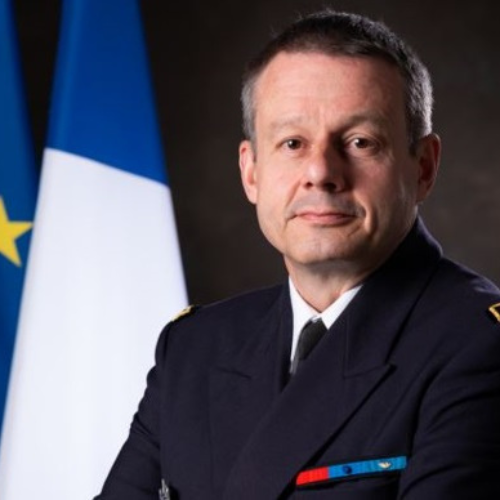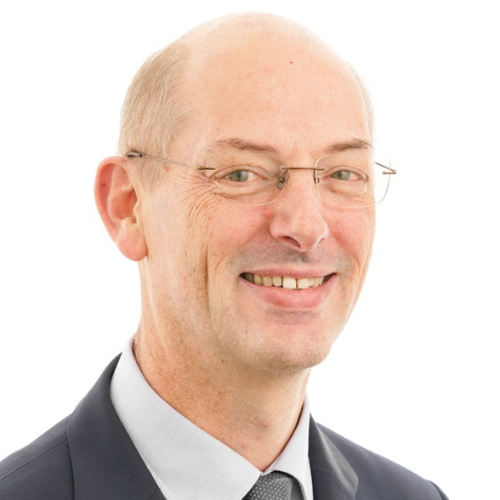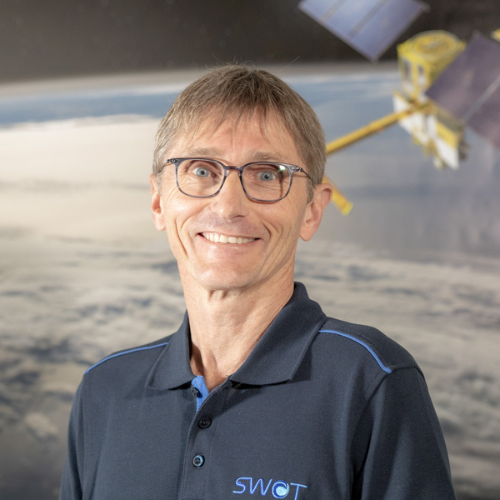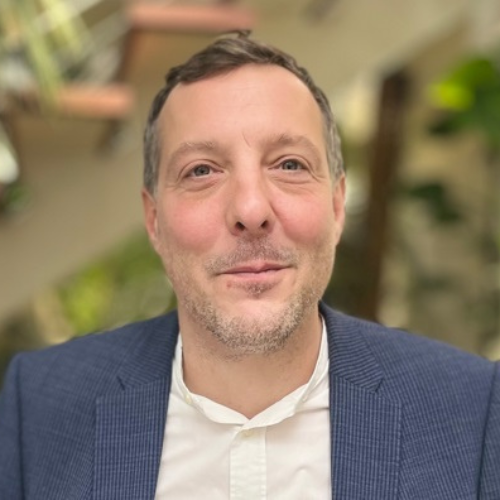
Patrick Aufort was appointed Deputy Director of the Defence Innovation Agency (AID) on October 1st, 2020 and Director on March 15th, 2023.
Patrick Aufort has served for 26 years within DGA (Direction Générale de l’Armement) of the French Ministry of Defence.
He was director of DGA Engineering and Integration from 2018 to 2020 and director of DGA Aero-Engine Testing from 2015 to 2018.
Previous roles were dedicated to engineering support and program management for a wide range of aeronautical acquisition programs, including head of the aircraft mission department at the management unit for aeronautical armament operations, program manager for the Maritime Patrol Aircraft, program manager for Air Command and Control Systems, Engineering manager for the French Hawkeye, Chief Engineer for the French AWACS and Technical Advisor in Electronic Warfare operations.
Patrick Aufort graduated as an engineer in both robotics and data processing from UPMC Paris VI University, France (Université Pierre et Marie Curie, UPMC, PARIS). He became a military engineer (”corps de l’armement”) after a competitive examination in 2008. He is a Legion of Honour knight and an officer of the National Order of Merit.
The design and use of Radar systems should be considered in the context of digitization of the battlefield, connectivity between the various components of an operational theater, diversity of environments (maritime, terrestrial, aerial, spatial), proliferation of new threats (conventional, asymmetric, low RCS, swarm, hyper-velocity…), and the need for electromagnetic coexistence or spectrum sharing among the different systems coexisting on a platform.
The R&D challenges identified by the AID to address these issues pertain to multifunctional (Radar, Communications, Electronic Warfare) systems and waveforms, AI-driven programmable digital architectures enabling high agility and dynamic resource optimization, MIMO (Multiple Input Multiple Output) systems that leverage spatial diversity and multistatic configurations for anti-stealth, as well as real-time spectrum monitoring devices. The needs cover a very wide frequency spectrum, ranging from low bands (HF to VUHF) for the development of long-range surveillance and anti-stealth radars, to the millimeter-wave band for the integration of compact radar systems on small platforms (drones, satellites, etc.). Passive radars, which exploit opportunistic or collaborative signals, represent a challenge for monitoring sensitive areas. New radar processing techniques, referred to as non-linear and iterative, particularly based on AI and HPC, need to be evaluated for the detection and identification of low RCS targets (drones, IEDs, etc.) in heterogeneous and noisy environments. A great challenge is also dedicated to composite materials and meta-surfaces, including spatial-temporal coded meta-surfaces, for stealth and antenna radiation applications.

Antoine Godard received the Engineering degree from Institut d’Optique Graduate School, Orsay, France, in 1998, and the PhD degree in 2003 and the “Habilitation à Diriger les Recherches” (HDR) in 2016, both from Université Paris-Saclay. He joined ONERA, the French national aerospace research centre, as a research scientist in 2003. His research involves laser applications and nonlinear optics with a special interest in optical parametric oscillators and their applications to atmospheric sensing. His interests also cover more basic research topics with the investigation of photon correlations by two-photon absorption in semiconductors. He has authored over 65 articles in peer-reviewed international journal and over 210 communications at international conferences (33 invited) and he holds two patents. He has been involved in various research projects and studies for the European commission, the French and European space (CNES and ESA) and defence (DGA and EDA) agencies, the French National Research Agency (ANR) as well as direct contracts with industry.
Since 2022, Dr. Antoine Godard has been the Scientific Director of Physics Domain of ONERA. As which, he has been in charge of the guidance of the research activities of three research departments (530 persons in total): Electromagnetism and radar; Optics and associated techniques; Physics, instrumentation, environment, and space.
Antoine Godard is also the president-elect of the French Optical Society (SFO, 2024-2026).
The revolutions brought about by artificial intelligence and the emergence of autonomous, interconnected systems are leading us to think of radar systems in terms of the co-design of technological components and signal processing. In particular, the digitization of systems makes it possible to develop cognitive radars capable of adapting dynamically to operational conditions and exploiting the complementarities of sensors. A major challenge is also to develop agile sensors or sensor networks that exploit multimodality – i.e. multistatism, multi-angularity, bandwidth, MIMO, radar-communication waveform, AI – and take advantage of signals of opportunity and new technologies – e.g. active metasurfaces, quantum sensors – to develop radar systems with unrivalled performance. Another challenge is to develop multi-sensor platforms providing enhanced data through the simultaneous and combined processing of multi-physical signals, particularly optical and radar.
In this presentation, different approaches to address these challenges in radar research and technology for the aerospace and defense sector will be illustrated through recent work carried out by ONERA. »

Pierre FOSSIER joined Thales in 1998, after 15 years at Dassault Electronique as head of airborne electronic warfare studies group, particularly in charge of upstream studies related to the RAFALE electronic sensors. At Thales, he was first appointed Deputy Technical Director of the “Airborne Systems” business group (combat aircraft and UAVs), then Vice-President in charge of technical strategy and international cooperation in research and technology, within the Aeronautics Division (encompassing avionics and airborne systems activities, both civil and military). In 2009, he was appointed Vice-President, Chief Technical Officer of the « Air Operations » division, merged into the « Land and Air Systems » activity in 2013. The “Land and Air Systems” activity provides solutions for air traffic management, military air operations command and control systems, surface-to-air weapon systems, surface radars, missile electronics, optronic equipment, tactical armaments and protected vehicles.
Pierre FOSSIER is a graduate of “Ecole Polytechnique” (X80) and of “Ecole Nationale Supérieure des Télécommunications » in Paris (1983). He was awarded “Chevalier de la Légion d’Honneur”, recipient of the French Medal of Aeronautics and is a former auditor of the 62nd national session of the “Institut des Hautes Etudes de la Défense Nationale” (IHEDN). He is a member of the steering committee of Civil Aeronautical Research Orientation Council (CORAC), President of the Foundation for Aeronautical and Space Research (FRAE) within the “Saint-Exupery” Research & Technology Institute, member of the High Scientific Committee of “Association Aéronautique et Astronautique de France” (AAAF), Correspondent Member of the Air and Space Academy, and qualified member of the Board of Directors of the “Institut Supérieur de l’Aéronautique et de l’Espace” (ISAE-SUPAERO) Foundation.
Over the last ten years, the world of radar has experienced two major revolutions: advanced microwave technologies and massive digital processing. Today, we are witnessing a new requirement: to take into account the variability/versatility of situations, in particular related to the environment and to new threats.
This translates in the development of concepts such as “adaptive” or “proactive” radar, collaborative radar, or even « augmented » radar. These are based on the two major challenges mentioned above, though deepening them: hardware integration (SiP, SoC) and embedded artificial intelligence.
In addition, new factors must be considered: environmental aspects (Eco-design, energy frugality), sovereignty and resilience of the supply chain, and industrial productivity: digital engineering, « digital twin », reduction of development cycles.
Finally, new breakthroughs are looming for the future: HPC, Quantum computing, etc. which will enable the acceleration of computation times for physical digital twins.
The Surface Water and Ocean Topography (SWOT) satellite was launched on December 16, 2022. This innovative altimetry mission is a joint project of the National Aeronautics and Space Administration (NASA) and the CNES, with contributions from the Canadian Space Agency (CSA) and the United Kingdom Space Agency (UKSA). Its primary science payload, the Ka-band Radar Interferometer (KaRIn), is a bistatic Synthetic Aperture Radar (SAR) that provides near global measurements of the height of fresh water over land as well as the sea surface over the oceans. These measurements are performed at significantly higher spatial resolutions than any prior altimetry mission, on 50-km swaths extending 10-60 km on both sides of nadir. In addition to ocean products on 250 m and 2 km grids, SWOT provides global snapshots of terrestrial water bodies whose surface area exceeds 250×250 m2 (lakes, reservoirs, wetlands) and whose width exceeds 100 m (rivers), at least twice every 21 days. An overview of the mission will be given, as well as examples illustrating how SWOT is bound to revolutionize oceanography and hydrology.

Roger Fjørtoft received the M.S. degree in electronics from the Norwegian Institute of Technology, Trondheim, Norway, in 1993, and the Ph.D. degree in signal processing, image processing, and communications from Institut National Polytechnique, Toulouse, France, in 1999.
He was a Senior Research Scientist with the Norwegian Computing Center, Oslo, Norway, from 2000 to 2003, and since then, has been with the French Space Agency (CNES), Toulouse, France. Since 2008 he is with the Radar Algorithms, Processing and Products Department working on the Surface Water and Ocean Topography (SWOT) mission, prepared jointly by NASA/JPL and CNES, and launched in December 2022. Dr. Fjørtoft coordinates the development of algorithms for the operational processing of SWOT High Resolution data at CNES, as well as the associated performance validation activities.
In this talk, it will be shown how reconfigurable intelligent surfaces can be used to multiply the possibilities offered by off-the-shelves automotive radar chipsets and how cost-effective beamformers can be designed using very simple electronics at 77GHz, which allow very flexible and real-time beam steering.
These, alongside a smart synchronization of the radar chip with the beamformers, allow scanning strategies offering unprecedented resolutions and performances.
The performances of our demonstrator as well as typical results obtained will be shown.

Geoffroy Lerosey received the Engineering degree from the École Supérieure de Physique et de Chimie Industrielles de la Ville de Paris (ESPCI Paris), Paris, France, in 2003, the master’s degree in electronics from the Université Pierre et Marie Curie, Paris, in 2003, and the Ph.D. degree in physics from the Université Paris Diderot, Paris, in 2006. He is currently on leave from academia to fully support the company’s development and bring his scientific expertise. He is the Co-Founder and the Inventor of the concepts behind Greenerwave, Paris, with Mathias Fink. He joined the University of California, Berkeley, Berkeley, CA, USA, as a Post-Doctoral Researcher, mainly on metamaterials and plasmonics. Coming back to France, he was appointed by the French main academic research organization Center National de la Recherche Scientifique (CNRS), Paris, in 2008, and started a group at the Institut Langevin (CNRS and ESPCI Paris), Paris. He has been invited more than 80 times to international conferences and has given invited seminars at many universities worldwide. He supervised eight Ph.D. students, six postdoctorals, and 20 master’s students. His research led to 100 scientific articles, 20 patents, and two startups. His research is in metamaterials and metasurfaces, time reversal and signal processing, subwavelength imaging, and focusing techniques, wavefront shaping in optics and RF, photonic and phononic crystals, and reverberating and locally resonant media, and spans all domains of wave physics from acoustics to optics.